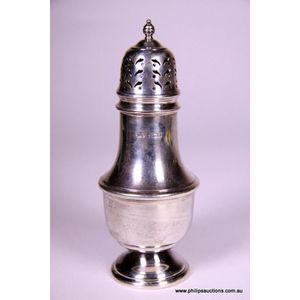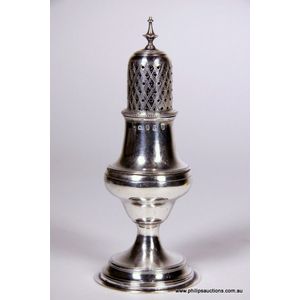George II Sterling Silver Sugar Caster, 1744 London
You must be a subscriber, and be logged in to view price and dealer details.
Subscribe Now to view actual auction price for this item
When you subscribe, you have the option of setting the currency in which to display prices to $Au, $US, $NZ or Stg.
- Caster - Casters are so-called because they ?cast? their contents over food. They consist of a container, usually in silver or pewter with a removable perforated top which allows for the sprinkling of condiments such as sugar, pepper and nutmeg.
- Knop (silver) - A knop on a silver item is either a bulbous protrusion mid way along a stem, such as on a candlestick or at the end of a stem, such as on a spoon, or a knob or finial on top of a cover or lid, that acts as a handle. On a stemmed item such as a candlestick there may be a series of knops of different shapes.
- Sterling Silver - Sterling silver is a mixture of 92.5% pure silver and 7.5% of another metal, usually copper. Fine silver is 99.9% pure silver, and is relatively soft and the addition of the very small amount of copper gives the metal enough strength and hardness to be worked into jewellery, decorative and household objects.
- Finial - An architectural decoration, found on the upper parts of of an object. On furniture they are usually found on pediments, canopies and shelf supports. On smaller ceramic or silver items, such as spoons, they may decorate the top of the item itself, or the lid or cover where they provide a useful handle for removal.
Finials have a variety of shapes and forms. They may be urn-shaped, baluster shaped round or spiral, but usually taper into an upper point. Many real life shapes may also be used as finials, such as pineapples, berries, pinecones, buds, lotus and acorns. Sometimes animals such as a lion are depicted, or fish and dolphins. - George Ii - George II (1683 - 1760) was King of Great Britain and Ireland from 1727 until his death in 1760.
This item has been included into following indexes:
Visually similar items

A fine sterling silver sugar caster, 1937/38 London, with maker's mark ABC, not identified, of elegant pedestal form with a pillar and globular body, finely pierced to the domed lid with diaper and floral designs, the tapering body with bright cut borders

A sterling silver Pillar pepper pot, 1989 Birmingham, with maker's mark for Elkington & Co, of traditional elongated pear shaped form with a waisted foot, having a pierced top and tiny finial, silver weight 90gr. Height 15 cm

A George III sterling silver pepper caster 1790 London, with maker's marks for Hester Bateman, with a narrow pierced dome upon a tapered and compressed lower section to a pedestal base; hallmarked to the upper body. Silver weight 84gr. Height 14.5 cm

A George III pedestal rope edge sterling silver pepper caster, 1785 London, with maker's mark for Hester Bateman, of typical pear shaped pillar form with a lattice wave pierced top, hallmarked to edge of base and with rare incised duty mark, silver weight
